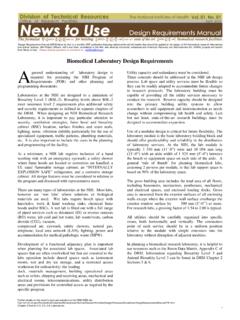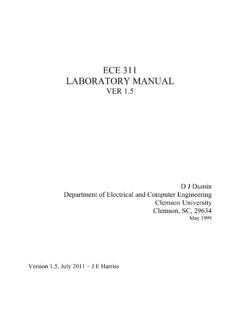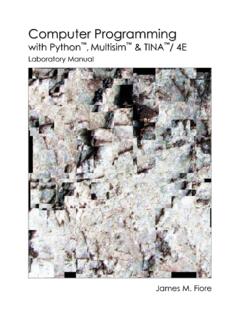Transcription of Trenching and Excavation Safety - Occupational Safety and ...
1 Trenching and Excavation SafetyOSHA 2226-10R 2015 Occupational Safety and Health Act of 1970 To assure safe and healthful working conditions for working men and women; by authorizing enforcement of the standards developed under the Act; by assisting and encouraging the States in their efforts to assure safe and healthful working conditions; by providing for research, information, education, and training in the field of Occupational Safety and health. Material contained in this publication is in the public domain and may be reproduced, fully or partially, without permission. Source credit is requested but not information will be made available to sensory-impaired individuals upon request. Voice phone: (202) 693-1999; teletypewriter (TTY) number: 1-877-889-5627. This publication is intended to provide information about OSHA s excavations standards at 29 CFR Part 1926, Subpart P.
2 The Occupational Safety and Health Act requires employers to comply with Safety and health standards promulgated by OSHA or by a state with an OSHA-approved state plan. However, this publication is not itself a standard or regulation, and it creates no new legal photo courtesy of Speed Shore and Excavation Department of LaborOccupational Safety and Health AdministrationOSHA 2226-10R 2015 Table of ContentsIntroduction ..1 What is the difference between an Excavation and a trench? ..1 What are the dangers of Trenching and Excavation operations? ..1 What do the OSHA Excavation standards cover, and how do they protect workers? ..1 What are the soil classification categories? ..2 What is a competent person? ..3 Preplanning ..3 Why is preplanning important to Excavation work? ..3 What Safety factors should be considered when bidding on a job?
3 4 How can employers avoid hitting underground utility lines and pipes during Excavation work? ..4 Protective Systems ..5 How can employers prevent cave-ins? ..5 What types of protective systems can employers use to protect workers from cave-ins? ..5 What other precautions do employers need to take to protect workers from cave-ins? ..7 What are the requirements for safely installing and removing protective systems? ..8 What do employers need to do to maintain materials and equipment used for protective systems? ..9 Additional Hazards and Protections ..9 What other Excavation hazards do employers need to address? ..9 What is the effect of water accumulation on Excavation Safety and what do employers need to do to protect workers from water-related Excavation hazards? ..10 How can employers protect workers from hazardous atmospheres inside excavations ?
4 11 What means of access and egress must employers provide? ..12 What protective equipment are employers required to provide to workers in pier holes and confined footing excavations ? ..12 When must employers conduct site inspections? ..12 Conclusion ..13 Workers Rights ..14 OSHA Assistance, Services and Programs ..14 Establishing an Injury and Illness Prevention Program ..15 Compliance Assistance Specialists ..15 Free On-site Safety and Health Consultation Services for Small Business ..15 Cooperative Programs ..16 Occupational Safety and Health Training ..17 OSHA Educational Materials ..17 NIOSH Health Hazard Evaluation Program ..18 OSHA Regional Offices ..19 How to Contact OSHA ..21 Trenching and Excavation Safety1 IntroductionExcavation and Trenching are among the most hazardous construction operations.
5 The Occupational Safety and Health Administration s (OSHA) Excavation standards, 29 Code of Federal Regulations (CFR) Part 1926, Subpart P, contain requirements for Excavation and Trenching operations. This booklet highlights key elements of the standards and describes safe work practices that can protect workers from cave-ins and other is the difference between an Excavation and a trench?OSHA defines an Excavation as any man-made cut, cavity, trench, or depression in the Earth s surface formed by earth removal. A trench is defined as a narrow Excavation (in relation to its length) made below the surface of the ground. In general, the depth of a trench is greater than its width, but the width of a trench (measured at the bottom) is not greater than 15 feet ( m).What are the dangers of Trenching and Excavation operations?
6 Trenching and Excavation work presents serious hazards to all workers involved. Cave-ins pose the greatest risk and are more likely than some other Excavation -related incidents to result in worker fatalities. One cubic yard of soil can weigh as much as a car. An unprotected trench can be an early grave. Employers must ensure that workers enter trenches only after adequate protections are in place to address cave-in hazards. Other potential hazards associated with Trenching work include falling loads, hazardous atmospheres, and hazards from mobile do the OSHA Excavation standards cover, and how do they protect workers?The standards apply to all open excavations made in the Earth s surface, including trenches. Following the requirements of the standards will prevent or greatly reduce the risk of cave-ins and other Excavation -related Safety and Health Administration2 What are the soil classification categories?
7 Some of the compliance methods permitted under the Excavation standards require a competent person to classify soil and rock deposits as: Stable rock; Type A soil; Type B soil; or Type C Appendix A to Subpart P of Part 1926 Soil Rock Natural solid mineral matter that can be excavated with vertical sides and remain intact while e A Cohesive soils with an unconfined compressive strength of tons per square foot (tsf) (144 kPa) or greater. Examples include: clay, silty clay, sandy clay, and clay loam. Certain conditions preclude soil from being classified as Type A. For example, no soil is Type A if it is fissured or has been previously disturbed. See Appendix A to Subpart P of Part 1926, paragraph (b) Definitions (Typ e A), for a detailed definition of Type A e B Includes cohesive soil with an unconfined compressive strength greater than tsf (48 kPa) but less than tsf (144 kPa) and granular cohesionless soils (such as angular gravel, similar to crushed rock, silt, silt loam, sandy loam, and, in some cases, silty clay loam and sandy clay loam).
8 See Appendix A to Subpart P of Part 1926, paragraph (b) Definitions (Type B), for a detailed definition of Type B e C Cohesive soil with an unconfined compressive strength of tsf (48 kPa) or less, granular soils (including gravel, sand, and loamy sand), submerged soil or soil from which water is freely seeping, submerged rock that is not stable, or material in a sloped, layered system where the layers dip into the Excavation or with a slope of four horizontal to one vertical (4H:1V) or steeper. See Appendix A to Subpart P of Part 1926, paragraph (b) Definitions (Type C), for a detailed definition of Type C and Excavation Safety3 Note: Unconfined compressive strength means the load per unit area at which a soil will fail in compression. It can be determined by laboratory testing or estimated in the field using a pocket penetrometer, thumb penetration tests, or other the video link below for additional guidance on classifying soil: is a competent person?
9 A competent person is an individual, designated by the employer, who is capable of identifying existing and predictable hazards in the surroundings or working conditions which are unsanitary, hazardous or dangerous to workers, and who is authorized to take prompt corrective measures to eliminate the Excavation standards, tasks performed by the competent person include: Classifying soil; Inspecting protective systems; designing structural ramps; Monitoring water removal equipment; and Conducting site is preplanning important to Excavation work?No matter how many Trenching , shoring, and backfilling jobs an employer has done in the past, it is important to approach each new job with care and preparation. Many on-the-job incidents result from inadequate initial planning. Waiting until after the Occupational Safety and Health Administration4work starts to correct mistakes in shoring or sloping slows down the operation, adds to the cost of the project, and makes a cave-in or other Excavation failure more Safety factors should be considered when bidding on a job?
10 Before preparing a bid, employers should know as much as possible about the jobsite and the materials they will need to have on hand to perform the work safely and in compliance with OSHA standards. A Safety checklist may prove helpful when employers are considering new projects. Factors to consider may include: Tr a f fi c Proximity and physical condition of nearby structures Soil classification Surface and ground water Location of the water table Overhead and underground utilities Weather Quantity of shoring or protective systems that may be required Fall protection needs Number of ladders that may be needed Other equipment can gather the information they need through jobsite studies, observations, test borings for soil type or conditions, and consultations with local officials and utility companies. This information will help employers determine the amount, kind, and cost of Safety equipment they will need to perform the work can employers avoid hitting underground utility lines and pipes during Excavation work?














